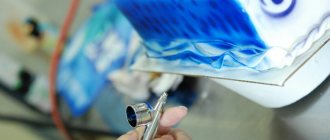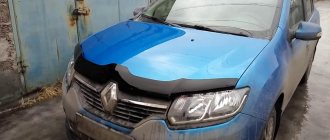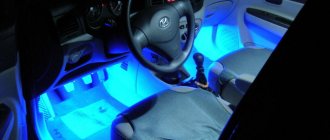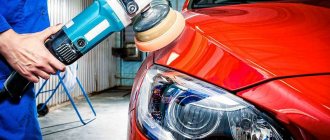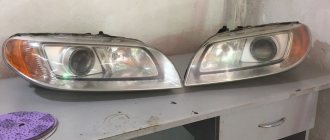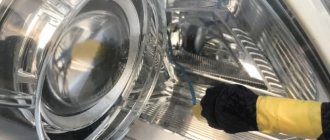Why periodically polish
Optics in a car are very important, but headlights are constantly exposed to various influences - sand, gravel, dirt, stones flying out from under the wheels of other cars. In addition, various insects affect the optics. All this, sooner or later, can lead to the light losing its brightness and directionality. In addition, the car loses its appearance, presentability and attractiveness.
There is no way to avoid this. Therefore, periodic cleaning, polishing, and repair of the headlight is necessary. It is best to tidy up the optics yourself - this way you can save a considerable amount of money and time. Plastic headlights can become cloudy and deteriorate due to careless cleaning with a cloth. The cloth may not be soft or clean enough, or may have been saturated with some harmful detergent.
What is important to know
It's no secret that some even use sandpaper to restore the surface of the head or rear optics of a car. On Drive2 you can find many similar stories and instructions.
Car optics need constant protection from negative influences from the environment, roads and other road users. The outer surface is constantly exposed to dust, dirt, mechanical damage, chemicals, etc. To clean it and restore its previous transparency and light transmittance, you need to take an appropriate care and restoration kit. The market range is huge, which is why many cannot decide what is best for them to use.
Some people buy a special 3M type kit, which already contains everything needed for polishing. Others use toothpaste, others use goyim toothpaste, and still others buy branded products that have received the most positive reviews.
The price of pastes varies, as does their composition. It’s quite difficult to say unequivocally which one is the best. Some believe that only abrasive, and diamond, paste is suitable for such tasks. Others categorically refuse the idea of using any abrasive for fear of damaging the headlight material.
To make the right choice, you need to consider several points:
- Material of manufacture. Some compounds are intended only for glass headlights, others exclusively for plastic ones. But there are also universal solutions;
- Severity of damage. There are chips and deep scratches that pastes cannot save from. But there are also simply cloudings, yellowing, minor scratches and abrasions;
- Matching the specific headlight. If you can find out which polishing agents are suitable for your type of optics, that would be great.
The polishing process itself is done with your own hands or with a grinder. In the latter case, it is better to use a device in which the speed is regulated.
You can process glass headlights yourself without fear of any special consequences. But when working with plastic, it is better to contact a car service. The only downside is that the price of the service is quite high. Both in Minsk and in Moscow. But there is a minimum risk of harming the car. What do you think about this? Leave feedback.
Tools and materials
The standard polishing arsenal must include tools that can be used to remove the caps. You should also stock up on masking tape. To sand deep scratches, you need sandpaper with different grits. The maximum grit range should be from 600 to 4000. To complete this job as quickly as possible, a sander or any other power tool will come in handy. Naturally, polishing a headlight with toothpaste will not work without the toothpaste itself. Moisten the surface to be sanded with clean water and rinse it.
Polishing plastic headlights with toothpaste requires a foam sponge. Felt or felt is also perfect. If you don’t have any of this, then you can use a polishing attachment for an electric drill.
Before starting work, the optics must be removed, having previously taken care of electrical safety, and the headlights must be fixed in a convenient position. Only then can you start working.
How to polish the inside of a headlight?
What should you do if, after polishing, the headlights remain dim and scattered? There is no need to panic and buy new optical instruments. You just need to clean the inside of the headlight .
Polishing headlights from the inside involves certain technological difficulties, since you need to remove the headlight and disassemble it. It is not recommended to do this without the appropriate skills; it is better to contact specialists. Otherwise, you may be left with a non-working headlight that is polished from the inside.
The technological process itself is not much different from the processing of the external side. To penetrate into curves, it is necessary to use various conical foam nozzles. They can be installed on a drill or screwdriver. All other operations are carried out in the same sequence.
There is an effective way to clean a headlight from contamination from the inside without the use of significant physical effort, power tools or special substances. You need to take a soft cloth, liquid dishwashing detergent and plain water.
It is poured inside a plastic or glass block, a rag is placed on top and detergent is added. After this, move the rag with water along the inner surface of the removed headlight using rocking movements from side to side for 30–40 minutes.
This leaves a clean, transparent, shiny surface. This method is effective when the inner plane of the headlight is dirty without mechanical damage. It allows you to preserve the structure without removing a layer of plastic or glass.
Is it possible to polish the inside of a headlight without disassembling it?
Yes it can be done. There are several ways, one of which allows you not to dismantle the headlight at all. Let's immediately consider an option that allows you to disassemble the headlight glass without removing it.
1. Foam rubber pieces are placed inside through the technological hole. After this, using a stream of air, they are driven inside the block and delicately remove dirt. True, you will have to work hard when removing the foam rubber from the headlight.
- there is more useful information here.
Another difficulty is that to implement this method you will need compressor equipment.
You might be interested in this article -
2. The second method does not involve dismantling. Through the technological hole (often this is the location of the low beam lamp) a small magnet is placed inside the headlight, wrapped in soft fabric, tied to a strong thread or wire (necessary to remove it from the headlight).
This is perhaps the most complete answer to the question: “How to polish plastic headlights yourself?” . Using the above information will save you a day, and maybe make money by polishing someone else's headlights.
Surfaces made of all kinds of plastics surround us. They are comfortable and practical, but are subject to deformation. Therefore, the question of how to polish plastic from scratches is always relevant. To ensure that your favorite smartphone, window sill or TV retains its attractive appearance, you need to familiarize yourself with our tips and, with the help of simple steps, transform them into almost their original appearance.
Polishing process
The technology includes several stages:
- Metal parts and rubber seals are closed.
- Preliminary cleaning of dust or dirt.
- Polishing headlights with toothpaste.
- Cleaning.
At the first stage, it is necessary to prepare the field for work.
The first step is to seal all metal parts or seals with tape to protect them from possible damage during the polishing process. Next, the entire surface is thoroughly cleaned of any contaminants. Not only dust and dirt are removed, but also various fats, oils, etc. For such cleaning, it is best to use a degreaser.
When all the preparatory work is completed, you can proceed to the rubbing process. Polishing headlights with your own hands with toothpaste involves applying the substance directly to the surface or to felt or any other soft cloth. To polish the surface, you need to make vigorous and very fast circular movements.
For greater efficiency and high results, it is recommended to use electric tools. It can be either a grinder, a hammer drill, or a drill. Power tools must be equipped with special polishing devices or grinding wheels on which toothpaste or any other material is applied. Polishing car headlights can also be performed using a specially designed composition based on diamond dust.
If it is necessary to process a glass or plastic headlight, it is important that the surface is not overheated. Otherwise, this may lead to cracks, and the plastic may become deformed at high temperatures. To prevent this, the temperature is constantly monitored during the process. This is done with one hand - if you can hold on to the glass, then everything is in order. It is important to pause during the process. If you have certain skills, you can easily achieve excellent results.
Sanding plastic
Plastic sanding is used when it is necessary to remove deep damage that cannot be sufficiently smoothed out in other ways. Plastic is easy to grind due to its relatively low melting point. In the case of measured and careful work, the result will be a uniform matte plane in place of the deep furrows. To sand plastic, follow this algorithm:
- Clear the workspace of those tools and objects that will not be needed when sanding plastic.
- Prepare several sanding sheets of different grits.
- They check the functionality of the grinding machine; when this tool is not available, it is possible to enhance the grinding effect with the help of a soap solution.
- A plastic object previously degreased with acetone is placed on the work table.
Sanding is a leisurely task that requires care and precision in every action.
During the process, monitor the temperature, since overheating is contraindicated for the material. They gradually move from coarse-grained to fine-grained skins. After processing with each piece of sandpaper, wipe the treated area with a dry cloth, this will avoid defects and prevent flaws from being missed - plastic shavings sometimes hide a missed scratch.
Features of glass polishing
Polishing a headlight with toothpaste, if the surface of the optical device is glass, is virtually no different from polishing plastic. But the process itself requires extreme accuracy. It should also be taken into account that the same work at a service station will cost much more. It is recommended to use brushes with a medium degree of hardness. The process is carried out until there are no scratches on the surface. Then sanding is carried out with felt or a towel, but without toothpaste. The entire process from start to finish will take from 30 minutes to a couple of hours. The total time depends on several factors:
- Size of scratches.
- The product used.
- Manual or automated polishing.
- Optics material.
If the scratch is quite deep, you can apply sandpaper treatment, but only for a rough draft. And after the scratch is destroyed, you can move on to the process of polishing and grinding the glass. There are situations when, after work, the headlight is still cloudy. In this case, the optics are completely disassembled and all actions are carried out, but from the reverse, inner side.
BMW motor
How to polish plastic with toothpaste
When the letters BMW are heard, an association immediately arises with words such as quality and dignity.
Which BMW engine can be installed on the Gazelle? Those who like to experiment use different engines. But in order to make such an installation, it is necessary to make some transformations in the Gazelle itself. Because one motor is a little longer, you have to cut off the manifold, the other motor is taller, then you need to make an additional hole in the Gazelle itself. But what car enthusiasts who want to combine economy and quality will not agree to.
Installed engine from BMW in Gazelle
This engine is so easy to handle and operate that in case of minor breakdowns or replacement of spare parts, you do not need to go to specialists for service, but can do everything in your garage. Oil also does not need expensive and high-quality oil. Because when engines were produced, oil production was in the first stages of development.
Most often, owners install a BMW M50 on a Gazelle. At the same time, it takes a little work to get it there, because the motor is 43.5 cm long and when installed, it goes under the bar of the car. We have to do a little work. The BMW M50 has an intake camshaft, it increases engine thrust at low speeds without losing power at high speeds. Motor weight 136 kg. compared to Iveco (250 kg).
We recommend watching: repairing and starting a BMW engine on a Gazelle.
BMW engines are classified:
- M50 V 20 - piston stroke 66 mm, power 150 hp, 6 cylinders (steel, direct arrangement), cylinder diameter 80 mm;
- M50 B25 - piston stroke 75mm, power 192 l/s, cylinder diameter 84mm;
- M50 V20TU Vanos – piston stroke 66 mm, power 150 l/s, torque 190 Nm.
Benefits of DIY polishing
Polishing a headlight with toothpaste is a simple process that everyone can do. But there are also other undeniable advantages of this method. So, the price of polishing at a service station will be about 800 rubles. In severe cases it may be higher.
At home, the same process will be practically free. Another advantage is time. Finally, the entire technology is performed without special tools and devices. Reviews say that this way you can polish a headlight in absolutely any conditions.
Remedies
Several such methods can be listed. Polishing plastic headlights can be done using various methods, even with toothpaste and at home. Here we will look at the most effective ways.
Method 1
In order to get rid of cloudy glass, there are various polishing products. Using a special paste you can restore the original transparency of glass
It is important to carefully study the instructions included with the material. The grinding work itself, after the instructions are read and carefully followed, will take a little time and can be done in any garage or at home where the car is parked
The procedure is as follows:
Remove the headlight lenses, clean them from dust and moisture, and dry them. The operation can be performed without removal. Make sure that the body along the contour of the headlight is covered with protective tape. If the damage is severe, such as deep chips or cracks, consider replacing the entire outer glass. To remove microcracks and scratches, use an abrasive, rubbing in a circular motion over the entire surface.
Take precautions when working with active chemicals. Remember that you should not use abrasives to polish the lenses themselves, and the abrasive leaves a white residue on the black rubberized seals. To polish headlights, use special wax and polishes; polish with diamond paste.
Don't forget to purchase a good sealant for mounting the glass on the headlight housing. Make sure that the product remains sealed at the end of the work.
Method 2
The method consists in polishing plastic elements using sandpaper and paste. Good quality paper is required. You will also need mounting tape and soap solution.
- The body around the headlights should be protected with mounting tape. Using tape may leave adhesive residue on the paintwork.
- We clean the lenses with a special cleaner designed for glasses and lenses. You can use a soap solution or a simple window cleaner.
- We begin to remove small scratches using sandpaper soaked in a soapy solution.
- At the next stage, you should once again go over the entire surface of the glass with sandpaper with a finer grain. Wash off the remains with soapy water.
- We begin polishing using special products - polishes. We sand with paste, then apply ointment with a sponge and rub it over the entire surface of the headlight glass. It is necessary to do this, because after processing it becomes cloudy. You can also apply a special varnish to achieve transparency and shine.
Method 3
Restoring plastic headlight lenses with toothpaste. Since a variety of dental products contain soda and silicon in the form of a dioxide compound, the use of toothpaste allows you to effectively polish the surface. In this case, the hygiene product plays the role of an abrasive and helps restore the damaged glass surface. In addition to toothpaste, during the work we will use:
- sponge;
- ordinary tap water;
- towel or napkin;
- rubber gloves;
- polish for final polishing.
The process of restoring headlight glasses is similar to the procedure described in method 2. Only instead of sandpaper, sanding is done with toothpaste and a dishwashing sponge.
All the methods described above involved manual polishing of plastic headlights, but using a machine will significantly speed up the whole process at home. The machine can also be used at the stage of processing with abrasive, toothpaste or sandpaper. In this case, you should set the machine at low speeds and use wheels with fine grain. Treatment with each circle is carried out for 2-4 minutes.
Minuses
With all the advantages, there are also disadvantages. The main disadvantage is that the effect is short-term, and the process itself must be repeated with sufficient regularity. In addition, if due care is not taken during the process, the glass can easily be damaged.
But in general, despite the shortcomings, home polishing of headlights is the best option when you need to quickly and inexpensively return your optics to their excellent appearance and performance characteristics. Owner reviews say that for greater effect you should purchase a special polish.
Remedies
Several such methods can be listed. Polishing plastic headlights can be done using various methods, even with toothpaste and at home. Here we will look at the most effective ways.
Method 1
In order to get rid of cloudy glass, there are various polishing products. Using a special paste you can restore the original transparency of glass
It is important to carefully study the instructions included with the material. The grinding work itself, after the instructions are read and carefully followed, will take a little time and can be done in any garage or at home where the car is parked. The procedure is as follows:
The procedure is as follows:
Remove the headlight lenses, clean them from dust and moisture, and dry them. The operation can be performed without removal. Make sure that the body along the contour of the headlight is covered with protective tape. If the damage is severe, such as deep chips or cracks, consider replacing the entire outer glass. To remove microcracks and scratches, use an abrasive, rubbing in a circular motion over the entire surface.
Take precautions when working with active chemicals. Remember that you should not use abrasives to polish the lenses themselves, and the abrasive leaves a white residue on the black rubberized seals. To polish headlights, use special wax and polishes, and polish with diamond paste. Don't forget to purchase a good sealant for installing glass on the headlight housing
Make sure that the product remains sealed at the end of the work.
Don't forget to purchase a good sealant for mounting the glass on the headlight housing. Make sure that the product remains sealed at the end of the work.
Method 2
The method consists in polishing plastic elements using sandpaper and paste. Good quality paper is required. You will also need mounting tape and soap solution.
- The body around the headlights should be protected with mounting tape. Using tape may leave adhesive residue on the paintwork.
- We clean the lenses with a special cleaner designed for glasses and lenses. You can use a soap solution or a simple window cleaner.
- We begin to remove small scratches using sandpaper soaked in a soapy solution.
- At the next stage, you should once again go over the entire surface of the glass with sandpaper with a finer grain. Wash off the remains with soapy water.
- We begin polishing using special products - polishes. We sand with paste, then apply ointment with a sponge and rub it over the entire surface of the headlight glass. It is necessary to do this, because after processing it becomes cloudy. You can also apply a special varnish to achieve transparency and shine.
Method 3
Restoring plastic headlight lenses with toothpaste. Since a variety of dental products contain soda and silicon in the form of a dioxide compound, the use of toothpaste allows you to effectively polish the surface. In this case, the hygiene product plays the role of an abrasive and helps restore the damaged glass surface. In addition to toothpaste, during the work we will use:
- sponge;
- ordinary tap water;
- towel or napkin;
- rubber gloves;
- polish for final polishing.
The process of restoring headlight glasses is similar to the procedure described in method 2. Only instead of sandpaper, sanding is done with toothpaste and a dishwashing sponge.
All the methods described above involved manual polishing of plastic headlights, but using a machine will significantly speed up the whole process at home. The machine can also be used at the stage of processing with abrasive, toothpaste or sandpaper. In this case, you should set the machine at low speeds and use wheels with fine grain. Treatment with each circle is carried out for 2-4 minutes.
